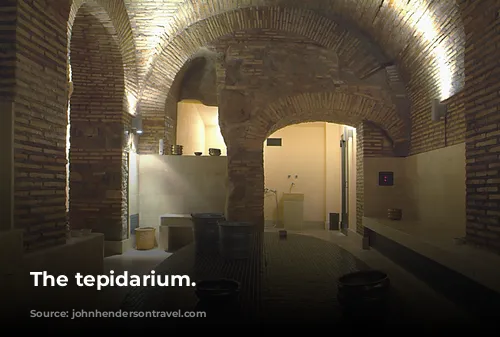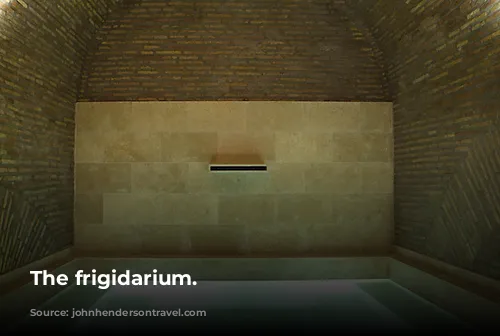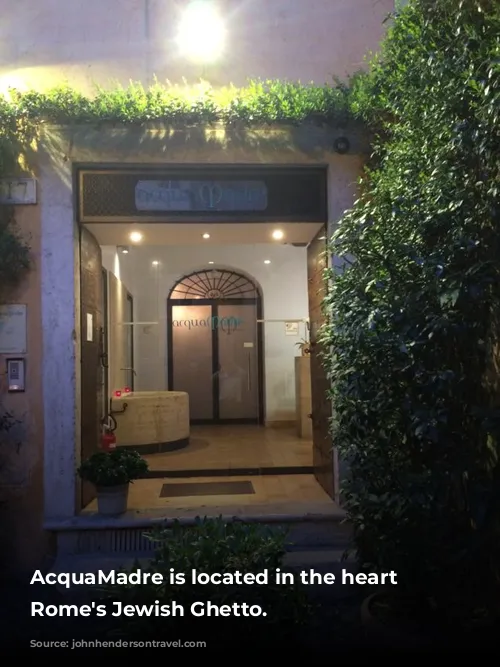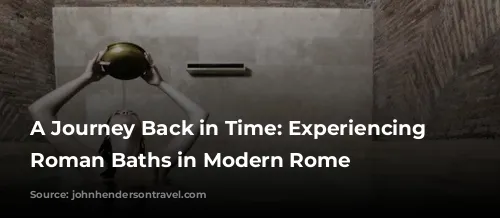It’s a warm, humid day in Rome, and I’m feeling the effects of two steam baths in the AcquaMadre thermal baths. The air is thick with heat, my skin is slick with sweat, and I’m completely relaxed, almost to the point of immobility. The experience is unlike anything I’ve ever felt before, a unique combination of intense heat and soothing calm.
A young woman, wearing baggy shorts and a t-shirt, kneels beside me on a long marble bench. She’s intently scrubbing my back and shoulders with a rough mitt, a process called “peeling,” designed to remove the dead skin accumulated during the steam baths. The sensation is unusual, almost like being gently scraped by a giant, furry creature. This “peeling” is an integral part of the ancient Roman bathing ritual, believed to help the body release toxins and excess fluids.

A Glimpse Into Ancient Rome
Looking around, I’m surrounded by brick archways and a high vaulted ceiling, bathed in the soft glow of red and white candles. The only sound is the gentle cascade of water, a soothing symphony that transports me to another time.
I close my eyes and imagine myself in Ancient Rome, a Roman senator perhaps, relaxing after a long day of debating in the Forum. Or maybe I’m a soldier, seeking solace after a grueling march through foreign lands. This peaceful haven is a far cry from the chaos and battles I envision. But it’s a peaceful respite, a moment of pure tranquility in the midst of history’s grandeur.
This isn’t just a day spa, it’s a journey into the past. AcquaMadre, with its soothing pools and traditional Roman bathing techniques, offers a glimpse into the daily lives of Romans centuries ago. It’s a reminder that even in the midst of a bustling modern city, traces of the past remain, waiting to be discovered.

Thermae: A Legacy of Relaxation
Two thousand years ago, thermal baths like this were commonplace in Rome. Known as “thermae” or “hammam,” they were the predecessors of modern spas, places where Romans of all social classes gathered to cleanse themselves, socialize, and relax.
The wealthy Romans, of course, had their own luxurious bathhouses on their vast estates. I’ve even seen remnants of these ancient baths during my bike rides along Appia Antica, the ancient road that once connected Rome to the Adriatic Sea. The ruins speak volumes about the importance of bathing in Roman culture.
The Romans were masters of relaxation, turning bathing into an art form. Thermae were more than just places to wash; they were social hubs, where people could catch up with friends, discuss current events, and enjoy a range of activities.
The sheer scale of these baths is astounding. The Baths of Diocletian, for instance, occupied a vast area, accommodating thousands of bathers at a time. Its remnants still stand today, transformed into the Basilica Santa Maria degli Angeli e dei Martiri. And then there are the Baths of Caracalla, another monumental example of Roman bath architecture, whose ruins can still be explored near the Circus Maximus.

A Modern Reimagining of Ancient Rituals
The AcquaMadre experience echoes the rituals of ancient Rome, from the different temperature rooms designed to open pores to the soothing cool-down phase. It’s a complete sensory journey, a chance to disconnect from the modern world and reconnect with our primal need for relaxation.
As I sit in the steam room, the “calidarium,” I feel the heat envelop me like a warm hug. The sweat pours down my body, and I feel my muscles loosen and relax. It’s almost a meditative experience, a chance to let go of stress and tension.
But the most surprising thing about this modern-day Roman bath is the feeling of connection to the past. As I lie in the cool “frigidarium” pool, I imagine the Romans who once bathed in these same pools, their conversations, their worries, their dreams. It’s a powerful reminder that even though centuries have passed, the human need for relaxation, for connection, for a sense of community, remains constant.

A Legacy of Relaxation, a Journey Through Time
My journey through the AcquaMadre thermal baths is more than just a relaxing experience; it’s a journey through time, a chance to connect with the ancient world and appreciate the enduring power of relaxation and self-care. It’s a reminder that even in our fast-paced modern lives, we can find peace and rejuvenation through simple pleasures like a warm bath, a soothing massage, and the quiet beauty of ancient history.
From the “peeling” ritual to the cool “frigidarium” pool, AcquaMadre allows me to experience a piece of Roman history firsthand. It’s a journey that leaves me feeling refreshed, revitalized, and deeply connected to the past.
